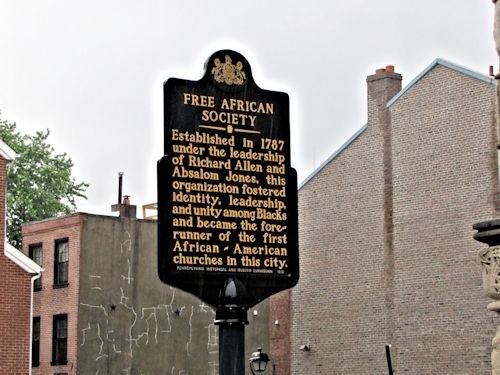Free African Society Historical Marker
Introduction
Text-to-speech Audio
Images
Free African Society Historical Marker, by Chris Martienssen on HMDB.org (reproduced under Fair Use).

Backstory and Context
Text-to-speech Audio
Dating to 1787, the Free African Society was the second mutual aid society dedicated to African-Americans in the United States, after the African Union Society of Newport, Rhode Island. Methodist minister Rt. Rev. Richard Allen and fellow clergyman Absalom Jones sought to create a community for fellow Black people in the city that was not based on religious beliefs. Members paid monthly dues to the society and could in turn seek aid after one year, provided they lived an "orderly and sober life," according to the society's founding articles. These articles specifically states that the society's goal was to support members who were ill as well as widows and fatherless children.
Joseph Clarke served as the organization's first Clerk and Treasurer. Other founding members were Samuel Baston, Joseph Johnson, Cato Freeman, Caesar Cranchell, James Potter, and William White. Other early members included Cyrus Bustill, James Forten, and William Gray. With the exception of Forten, these early members were formerly enslaved.
While the society did not have specific religious ties, it did adopt some Quaker practices, such as observing fifteen minutes of meditative silence at the beginning of each meeting. Allen found this in conflict with his Methodist faith and left the society two years after its founding. Jones remained with the society and became its president.
In addition to aiding members of the Black community who were facing hardship, the society provided aid to the city as a whole. Philadelphia's yellow fever epidemic of 1793 killed thousands of people, and the society responded to help the city. The society was also useful in fostering social and business relationships between Black Philadelphians.
The Free African Society was the forebear of several African-American-led churches in the city. In 1794, the society founded the African Episcopal Church of St. Thomas. It offered the position first to Allen to invite him back to the society; when he declined, Jones accepted a position as pastor. Allen led the Methodist congregation, Bethel African Methodist Episcopal Church, which would later serve as a way station on the Underground Railroad. The historical marker placed in 1991 is near this church.
Early Pan-Africanist thought underpinned the philosophy of the Free African Society, with African heritage at the center of some members' identities. Allen supported emigration to Africa and Haiti. Several decades later, in 1824, more than six thousand Black people from Philadelphia and other coastal cities migrated to Haiti.
The society was a precursor to co-operatives that would emerge in Philadelphia later in the nineteenth century. W. E. B. Dubois mentioned the society in his 1907 report Economic Co-operation among Negro Americans.
Sources
Free African Society. Preamble and Articles of the Free African Society. Philadelphia, PA. 1787. Explore PA History. Accessed April 18th 2021. http://explorepahistory.com/odocument.php?docId=1-4-34.
Makalani, Minkah. Pan-Africanism, Africana Age: African and African Diasporan Transformations in the 20th Century. Schomburg Center for Research in Black Culture, New York Public Library. 2011. Accessed April 18th 2021. http://exhibitions.nypl.org/africanaage/essay-pan-africanism.html.
Miller, Richard E. Free African Society, Historical Marker Database. July 16th 2020. Accessed April 18th 2021. https://www.hmdb.org/m.asp?m=8920.
Philadelpha Area Cooperative Alliance. Philadelphia Co-op History. Accessed April 18th 2021. https://philadelphia.coop/phillycoops/philacoophistory/.
Yee, Shirley. Free African Society of Philadelphia (1787 - ?), BlackPast. February 10th 2011. Accessed April 18th 2021. https://www.Blackpast.org/african-american-history/free-african-society-philadelphia-1787.
https://www.hmdb.org/PhotoFullSize.asp?PhotoID=322736
